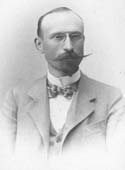 |
||||
|
|
||||
|
|
||||
 Salginatobel Bridge  LEARN MORE... Learn about Maillart's solution to the problem of cracks in the abutments of the Zuoz bridge. Vessy Bridge 
|
SWISS
ENGINEERS Like his teacher Ritter, Robert Maillart (1872–1940) studied at the Eidgenössische Technische Hochschule (Federal Institute of Technology), graduating with an engineering diploma in 1894. He would go on to become the leading early twentieth-century engineer in reinforced concrete. He was the first to develop concrete structures that satisfied the goals of good structural art: efficiency (safe performance with minimum materials), economy (accountable to the public welfare and or to private industry with competitive costs), and elegance in design. Maillart revolutionized concrete bridge design by the application of several key concepts. First, Ritter had taught him that the straight deck of a bridge could serve to stiffen the arch so that it could be elegantly thin. Second, he valued the appearance of exposed concrete and increasingly avoided using stone to cover the supporting material. Finally, his streamlined designs united the deck, the walls, and the arch of the bridge to create one monolithic arch. The bottom curved slab or arch is connected to the vertical walls, which themselves connect to the top roadway slab. This construction forms hollow boxes, and the three elements—arch, walls, and decks—efficiently carry the load. These innovations led to masterpieces like the Salginatobel and Vessy Bridges. An extraordinary feature of some of Maillart’s
bridge projects is that they were completed on time or early and under
budget. This illustrates the designer’s responsiveness to a crucial
imperative of structural design: economy. His major works were often
the result of public competitions in which expense was a compelling
issue for the judges. For example, his design was one of nineteen submitted
for the Salginatobel project. His pure form was not only beautiful but
also the least expensive and thus went into construction in 1929.
|
|
